Silent Era Home Page > Home Video > The Phantom of the Opera

Reviews of silent film releases on home video.
Copyright © 1999-2025 by Carl Bennett
and the Silent Era Company.
All Rights Reserved. |
|
The Phantom of
the Opera
(1925)
|
One of the best-known of all silent era films is hardly one of the best. The Phantom of the Opera (1925) has acquired an apocryphal reputation over the years as one of the quintessential horror films, due in no small part to Lon Chaney’s deserved reputation as a makeup master and character actor, Universal’s reputation as a horror film producer in the 1930s and 1940s, and the stills from the film reproduced on countless pages of Famous Monsters of Filmland magazine. But the film itself has aged poorly due to its slow pacing and maudlin moments.
Much of the blame lies with director Rupert Julian. We attribute the dragging pace to Julian, as well as the at-times melodramatic gesticulation and posturing of Mary Philbin and the pulp-story spookiness of Inspector Ledoux. We abhor the number of times ballet dancers twirl around — clutching their tu-tus — to express their fright, and their stagey flock-of-geese blocking. And what is the point of the ‘messenger from the shadows’ that passes Ledoux and Raoul later in the film?
Yet, despite Mr. Julian’s shortcomings, the film endures. And the main reason is Lon Chaney. The image of a maskless Erik is an easy one to call up in the minds of film lovers worldwide — it is an image that is among the most cherished of moments in world cinema. The film continues to be one of the biggest draws at modern silent film showings and one of the most collected of silent era films. We recommend that serious collectors have at least two copies: the original 1925 and 1929 rerelease versions.
When the film premiered in April 1925 it was presented in a ten-reel version, with a few Technicolor sequences. A few scenes were removed for the film’s August 1925 New York premiere and general release. When the film was being prepared for a December 1929 reissue, Universal executives decided that talking sequences had to be added along with synchronized music and sound effects. New dialog, ballet and opera performance sequences were shot (all minus the participation of Chaney, who was now under contract at MGM). Other actors were replaced for sound retakes. The film was resequenced and retitled, cutting in new sound sequences and cutting out thousands of feet of footage. Scenes were removed altogether, compressed, or combined with other scenes. When it was released to theaters, the poorly-executed sound version of The Phantom of the Opera was only seven or eight reels long.
The existence of multiple versions of the film requires some clarification (for us as much as for anyone else) of the differences between the 1925 versions (domestic and international) and the 1929 (domestic sound rerelease) version and the 1930 (international sound rerelease) version. According to sources more informed than us, the soundtrack from the 1929 version has apparently been partially lost but much or all of the soundtrack for the 1930 version has survived. Definitively, one must also consider the January 1925 Los Angeles preview version, and the world premiere version which was presented to San Francisco audiences in April-May 1925 — neither of which are known to have survived.
The 1929 sound version begins with a post-main-titles sequence that is obviously a new synchronized scene. A character with a lantern in the tunnels under the opera house (who is seen only briefly in the 1925 version) is speaking a prologue for the audience, but the footage is now mute. The soundtrack to this section has not yet been recovered, but the script for this scene does survive and is now vocalized in synchronization by an actor at some live presentations of the film.
Other reshot sound sections include new ballet and opera performances, and (reputedly) a dialogue scene between Mary Philbin and Norman Kerry. Edward Martindel replaced John Sainpolis as Raoul’s brother in the 1929 sound retakes. Mary Fabian became Carlotta and Fay Holderness played her mother in sound retakes, while Virginia Pearson’s 1925 performance as the diva Carlotta became, through retitling, that of the mother of Carlotta in the 1930 version (which removed the Holderness performance but retained Fabian’s). Confused yet? The situation is not eased by recent home video versions that identify the source print as either the 1929 or the 1930 version, sometimes in internal conflict between their audio commentary and packaging. Scott MacQueen has identified the most-commonly available and best surviving print as the 1930 international version. If Martindel and Holderness did actually appear in the 1929 version, they aren’t seen in the version commonly seen today, which would substantiate MacQueen’s assertation. Some have identified that print as the 1930 silent international version, prepared from the 1929 sound version.
The surviving footage in the 1929 version differs slightly from the 1925 version as it was taken of the same performances, at the same time, from a different camera. To save additional wear on the domestic negative of major productions, an international negative was often prepared from footage taken from a second camera. If the footage in the surviving 1925 print is to be assumed as the domestic negative, then the 1929 version was prepared from the international negative.
Yet, to perhaps throw more confusion into the mix, we are prepared to state our guess (based on inspection of the surviving footage) that the surviving 1925 print is actually the international version prepared from B camera footage and that the surviving 1929 version is the domestic sound rerelease that was prepared from A camera footage. When the actors’ 1924-1925 performances are identical, the 1929 version features footage that presents better internal composition and framing of the action than the footage in the 1925 version. The position of foreground actors in relation to foreground props or background extras or action is consistently asthetically better in the 1929 footage.
What also must be considered, if this premise is to be accepted, is that the 1925 print may not accurately represent the absolute continuity of the 1925 domestic general release version of the film. Subtle differences in the edited length of shots, sometimes even in the intertitles’ content, are inherent in the process of assembling two separate negatives.
As much as home video producer David Shepard thought that the 1929 rerelease’s editing was brilliant, we beg to disagree strongly. While the choppy editing of the 1929 reissue is utilitarian and does shorten director Julian’s sluggish film, we prefer the continuity of the original 1925 version. The progression of the storyline, the development of characters and the visual continuity makes far more sense in the original version. Our hope is that someday someone will recreate the original 1925 continuity using the higher-quality footage from the 1929 version when it matches footage in the original version.
For purposes of clarity, when we refer here to the two surviving versions of the film, we will identify source prints simply as the 1925 version and the 1929 version.
— Carl Bennett
|
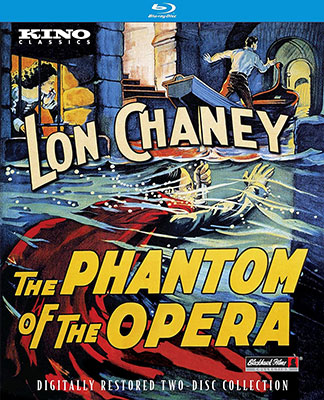 Kino Classics Kino Classics
2015 Blu-ray Disc edition
The Phantom of the Opera (1925) [1929 silent rerelease version], color-toned black & white and color, 92 minutes, not rated, and The Phantom of the Opera (1925) [1929 silent rerelease version], color-toned black & white and color, 78 minutes, not rated, with The Phantom of the Opera (1925), color-toned black & white, 114 minutes, not rated, Paris from a Motor (1925), color-tinted black & white, 3 minutes, not rated, and A Trip on the Seine (1925), color-toned black & white, 3 minutes, not rated.
Kino Lorber, K20139, UPC 7-38329-20139-5.
One single-sided, dual-layered, Region 0 Blu-ray Disc; 1.19:1 aspect ratio picture (1929 version) in pillarboxed 16:9 (1920 x 1080 pixels) 24 fps progressive scan image encoded in SDR AVC format at 32.2 Mbps average video bit rate; LPCM 2.0 stereo sound encoded at 2.3 Mbps audio bit rate (music and commentary); English language intertitles, no subtitles; 10 chapter stops (24 fps and 20 fps versions); and one single-sided, dual-layered, Region 0 Blu-ray Disc; 1.33:1 aspect ratio picture (1925 version) in pillarboxed 16:9 (1920 x 1080 pixels) 24 fps progressive scan image encoded in SDR AVC format at 28.2 Mbps average video bit rate; LPCM 2.0 stereo sound and mono sound encoded at 1.5 Mbps audio bit rate; English language intertitles, no subtitles; 10 chapter stops; standard two-disc BD keepcase; $39.95.
Release date: 13 October 2015.
Country of origin: USA
Ratings (1-10): video: 8 / audio: 8 / additional content: 8 / overall: 8.
|
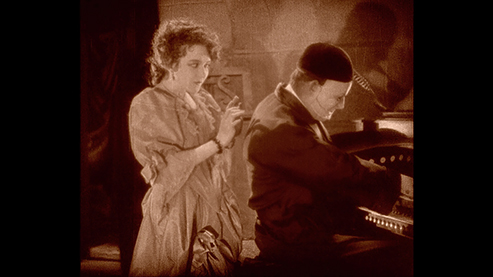
This Blu-ray Disc edition, produced by David Shepard and Bret Hampton, effectively replaces the Blu-ray Disc from Image Entertainment noted below. One immediate advantage of this edition over the Image edition is that its nearly identical content is delivered on two discs rather than being compressed onto one. The high-definition video transfers of the 1929 sound reissue version of the film also feature the two-color Technicolor sequences. The 1929 version is presented twice in the edition (transferred at 20 fps and at 24 fps), in addition to the original 1925 version and an abbreviated presentation of the 1930 sound rerelease version.
The 1929 version is presented in a new high-definition transfer at 20 frames per second, with an orchestral music score by Gabriel Thibaudeau (commissioned by La Cinemateque Quebecoise), recorded in 1992 by I Musici de Montreal, conducted by Yuri Turovsky, with pipe organ and opera soprano Claudine Coté. This presentation is supplemented by full-length audio commentary by Chaney expert Jon C. Mirsalis.
The 1929 version is presented again in a transfer at 24 frames per second with the historic Gaylord Carter theater organ score, and with a new music score by the Alloy Orchestra.
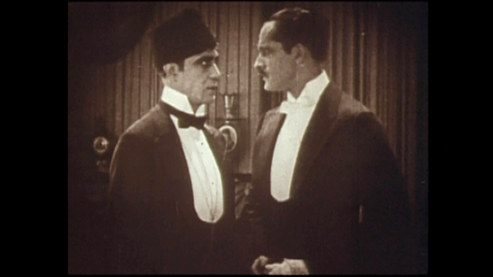
The original 1925 version has been transfered at standard-definition from an 8mm reduction source print, and is presented with a piano music score by Frederick Hodges. The standard resolution master has, at least, been encoded to the Blu-ray Disc in a smooth progressive-scan format. Still frames are relatively smooth instead of the jagged hard encoded the standard format pixels into a high-definition format, as with some early Blu-ray Disc editions. This pillarboxed presentation is a visual improvement over the Image Entertainment Blu-ray Disc edition of the 1925 version that is noted below, which had all of its content compressed to fit onto one disc.
For the first time on home video, lengthy excerpts from the 1930 sound rerelease of the film are presented from the surviving Vitaphone discs. The only surviving reel from the 1930 sound rerelease (black & white) and selected portions of the 1929 rerelease (color-toned black & white) are synchronized to the sound for a rough reconstruction of the 1930 version (54 minutes).
The edition’s supplemental material includes the original scenario, scrolled in real-time as white type on a black background and accompanied by music (91 minutes); the original theatrical trailer (3 minutes); a video interview with composer Gabriel Thibaudeau (10 minutes); and two excerpts from Burton Holmes travelogue films showing the Paris of the mid-1920s (7 minutes total).
This Blu-ray Disc edition is highly recommended.
|
|
This Regions ABC Blu-ray Disc edition is available directly from . . .
|

|
|
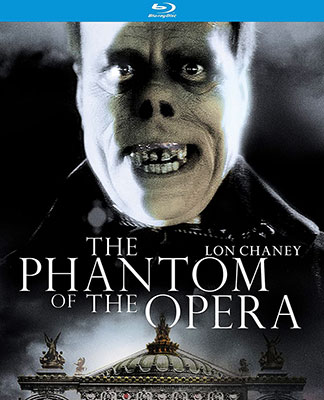 Film Preservation Associates Film Preservation Associates
2011 Blu-ray Disc edition
The Phantom of the Opera (1925) [1929 silent rerelease version], color-toned black & white and color, 92 minutes, not rated, and The Phantom of the Opera (1925) [1929 silent rerelease version], color-toned black & white and color, 78 minutes, not rated, with The Phantom of the Opera (1925), color-tinted black & white, ? minutes, not rated.
Film Preservation Associates, distributed by Image Entertainment, ID7542DSBD, UPC 0-14381-75425-4.
One single-sided, dual-layered, Region A Blu-ray Disc; 1.19:1 aspect ratio picture (1929 version) in pillarboxed 16:9 (1920 x 1080 pixels) 24 fps progressive scan image encoded in SDR AVC format at 14.4 Mbps average video bit rate, and 1.33:1 aspect ratio picture (1925 version) in windowboxed 16:9 (1920 x 1080 pixels) 24 fps progressive scan image encoded in SDR AVC format at 6.0 Mbps average video bit rate; LPCM 2.0 stereo sound encoded at 2.3 Mbps audio bit rate (1929 version at 24 fps, Alloy Orchestra and Carter music), LPCM 2.0 stereo sound encoded at 2.3 Mbps audio bit rate (1929 version at 20 fps, Thibaudeau music and commentary), and LPCM 2.0 stereo sound encoded at 1.5 Mbps audio bit rate (1925 version, Hodges music); English language intertitles, no subtitles; 12 chapter stops (1929 version) and 12 chapter stops (1925 version); standard BD keepcase; $39.98.
Release date: 1 November 2011.
Country of origin: USA
Ratings (1-10): video: 8 / audio: 8 / additional content: 8 / overall: 8.
|
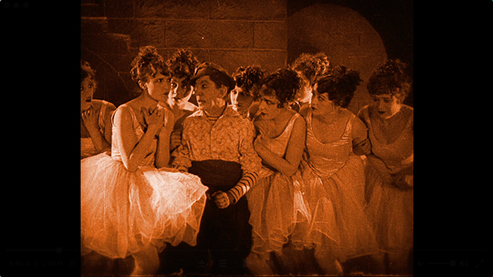
This first Blu-ray Disc edition, produced by David Shepard, features new HD video transfers of the 1929 sound reissue version of the film also features the two-color Technicolor sequences. The 1929 version is presented twice in the edition (transferred at 20 fps and at 24 fps), along with the original 1925 version. The scan has not been digitally stabilized or cleaned to remove dust, speckling, emulsion scrapes, or other print flaws.
The 1929 version is presented at 20 frames per second with the same orchestral music score by Gabriel Thibaudeau as the Kino edition noted above. This presentation is supplemented by full-length audio commentary by Chaney expert Jon Mirsalis. The 1929 version is presented again in a transfer at 24 frames per second with the historic Gaylord Carter theater organ score, and with a new music score by the Alloy Orchestra.
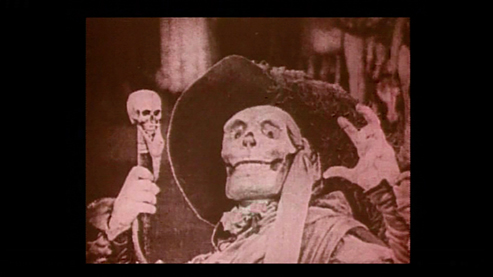
The original 1925 version has been transfered at standard-definition in a windowboxed video transfer from an 8mm reduction source print. The film is presented with a piano music score by Frederick Hodges.
It was quickly discovered that the first pressings of this edition had a number of mastering flaws, the foremost being that the stereo music scores had been accidently mastered in mono sound. The Gaylord Carter score was noticably out-of-sync for several minutes. The main menu of that first edition was also difficult to navigate, with versions of the film selected by identification of the music score only. Switching between the versions was also difficult. The disc was reissued with mastering and menu changes. The visual content was identical. We have reviewed the corrected and remastered edition.
Both the uncorrected and corrected versions of this Blu-ray Disc edition are now out-of-print, however, the 2015 Kino Lorber Blu-ray Disc edition is of similar content and quality.
|
This Region A Blu-ray Disc edition has been discontinued
and is . . .
|

|
|
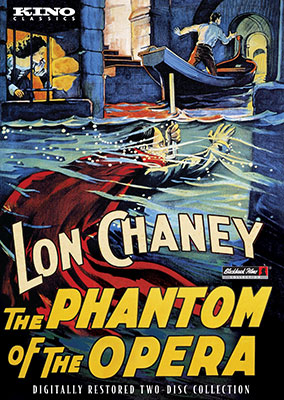 Kino Classics Kino Classics
2015 DVD edition
The Phantom of the Opera (1925) [1929 silent rerelease version], color-toned black & white and color, 92 minutes, not rated, and The Phantom of the Opera (1925) [1929 silent rerelease version], color-toned black & white and color, 78 minutes, not rated, with The Phantom of the Opera (1925), color-toned black & white, 114 minutes, not rated, Paris from a Motor (1925), color-tinted black & white, 3 minutes, not rated, and A Trip on the Seine (1925), color-toned black & white, 3 minutes, not rated.
Kino Lorber, K20138, UPC 7-38329-20138-8.
One single-sided, single-layered, Region 0 NTSC DVD disc; 1.19:1 aspect ratio picture (1929 version) in pillarboxed 4:3 (720 x 480 pixels) interlaced scan image encoded in SDR MPEG-2 format at ? Mbps average video bit rate (capable of progressive scan upscaling to 60 fps); Dolby Digital (AC3) 2.0 stereo sound encoded at 192 Kbps audio bit rate; English language intertitles, no subtitles; 8 chapter stops (24 fps and 20 fps versions); and one single-sided, dual-layered, Region 0 NTSC DVD disc; 1.33:1 aspect ratio picture (1925 version) in windowboxed 4:3 (720 x 480 pixels) interlaced scan image encoded in SDR MPEG-2 format at 3.8 Mbps average video bit rate (capable of progressive scan upscaling to 30 fps); Dolby Digital (AC3) 2.0 stereo and mono sound encoded at 192 Kbps audio bit rate; English language intertitles, no subtitles; 8 chapter stops; standard two-disc DVD keepcase; $29.95.
Release date: 13 October 2015.
Country of origin: USA
Ratings (1-10): video: 7 / audio: 8 / additional content: 7 / overall: 7.
|
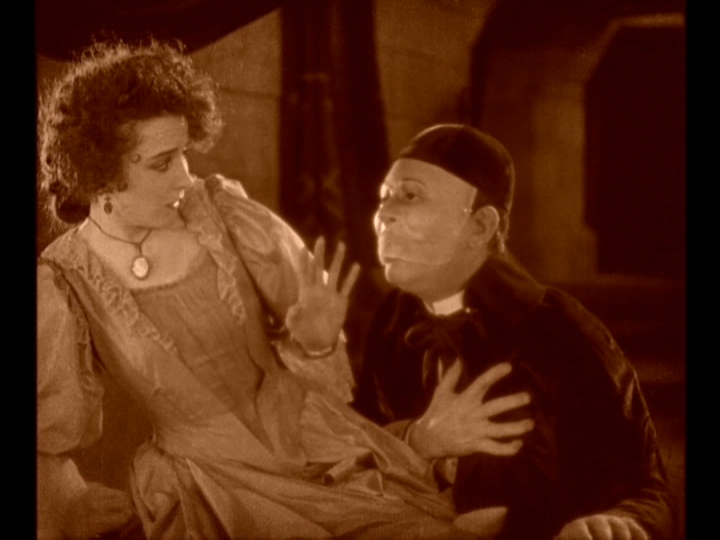
This DVD edition, produced by David Shepard and Bret Hampton, features high-definition video transfers of the 1929 sound reissue version of the film also feature the two-color Technicolor sequences. The 1929 version is presented twice in the edition (transferred at 20 fps and at 24 fps), in addition to the original 1925 version and an abbreviated presentation of the 1930 sound rerelease version.
The 1929 version is presented in a new high-definition transfer at 20 frames per second, with an orchestral music score by Gabriel Thibaudeau (commissioned by La Cinemateque Quebecoise), recorded in 1992 by I Musici de Montreal, conducted by Yuri Turovsky, with pipe organ and opera soprano Claudine Coté. This presentation is supplemented by full-length audio commentary by Chaney expert Jon C. Mirsalis.
The 1929 version is presented again in a transfer at 24 frames per second with the historic Gaylord Carter theater organ score, and with a new music score by the Alloy Orchestra.
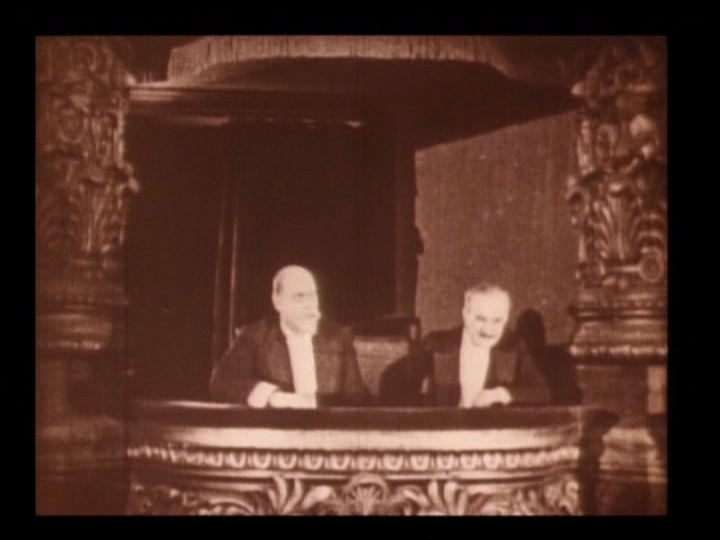
The original 1925 version (image above) has been transfered at standard-definition from an 8mm reduction source print, and is presented in a windowboxed image with a piano music score by Frederick Hodges.
For the first time on home video, lengthy excerpts from the 1930 sound rerelease of the film are presented from the surviving Vitaphone discs. The only surviving reel from the 1930 sound rerelease (black & white) and selected portions of the 1929 rerelease (color-toned black & white) are synchronized to the sound for a rough reconstruction of the 1930 version (54 minutes).
The edition’s supplemental material includes the original scenario, scrolled in real-time as white type on a black background and accompanied by music (91 minutes); the original theatrical trailer (3 minutes); a video interview with composer Gabriel Thibaudeau (10 minutes); and two excerpts from Burton Holmes travelogue films showing the Paris of the mid-1920s (7 minutes total).
The film has never looked as good on DVD as it does here and this edition is highly recommended for those who prefer DVD over Blu-ray Disc.
|
|
This Region 0 NTSC DVD edition is available directly from . . .
|

|
|
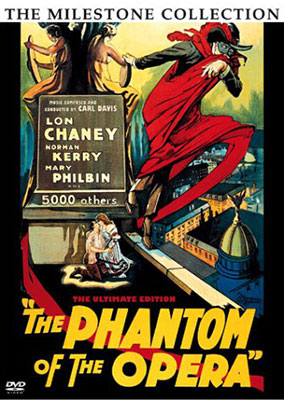 The Milestone Collection The Milestone Collection
2003 DVD edition
The Phantom of the Opera (1925), black & white, 110 minutes, not rated, and The Phantom of the Opera (1925) [1929 silent rerelease version], color-tinted black & white and color, 98 minutes, not rated.
Milestone Film & Video, distributed by Image Entertainment, ID0209MLSDVD, UPC 0-14381-02092-2.
Two single-sided, single-layered, Region 1 NTSC DVD discs; 1.33:1 aspect ratio picture (1925 version) and 1.19:1 aspect ratio picture (1929 version) in windowboxed 4:3 (720 x 480 pixels) interlaced scan image encoded in SDR MPEG-2 format at 7.0 Mbps average video bit rate (capable of progressive scan upscaling to 60 fps); Dolby Digital (AC3) 2.0 stereo sound encoded at 224 Kbps audio bit rate (Davis music), Dolby Digital (AC3) 2.0 mono sound encoded at 224 Kbps audio bit rate (1930 soundtrack), and Dolby Digital (AC3) 2.0 mono sound encoded at 224 Kbps audio bit rate (commentary); English language intertitles, no subtitles; 23 chapter stops (1929 version) and 28 chapter stops (1925 version); one-page insert sheet; double-wide two-disc DVD keepcase; $24.99.
Release date: 9 September 2003.
Country of origin: USA
Ratings (1-10): video: 6 / audio: 8 / additional content: 8 / overall: 6.
|
|
With no shortage of home video editions of The Phantom of the Opera available to the DVD consumer one would think that yet another edition of the film would not be cause for celebration. Yet, here is an intriguing collection of material that is likely to be of high interest to the silent film enthusiast.
Milestone Film & Video is the first home video producer to offer the complete original 1925 version of the film on DVD. And while this version has not survived in the best of condition, it is largely intact and offers the viewer a more coherent storyline than the reedited 1929 sound rerelease version.
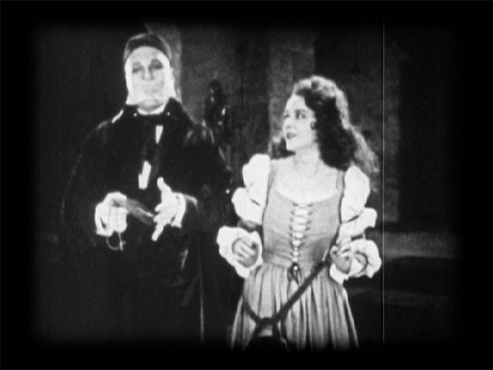
It appears that this edition of the 1925 version has been transferred from a 16mm reduction print (and we have never seen this version of the film in anything better than 16mm). The windowboxed natural-speed video transfer is without hard-cropped edges so that all of the surviving 16mm image will be visible on most televisions. Either the reduction print or the transfer has been prepared from at least two different source prints, the second filling in short sections of footage missing from the first print. The 16mm source print is generally good to very-good in image quality, with a soft image details and a slightly to sometimes pronounced contrastiness. This new video transfer is an improvement over the transfer that was available on the 1990 Image Entertainment laserdisc, making this version watchable (the 1990 laserdisc was flatly color-toned and presented without music). According to Scott McQueen’s audio commentary, the 1925 domestic general release version (we disagree, see commentary at left) survives in this source print. This print does not feature the Technicolor Bal Masque footage which, here, is black & white and shot from slightly different camera angles than the color footage. This edition of the 1925 version features a stereo music score composed and performed on (sometimes pleasing, sometimes annoyingly synthetic) digital keyboards by Lon Chaney enthusiast Jon C. Mirsalis.
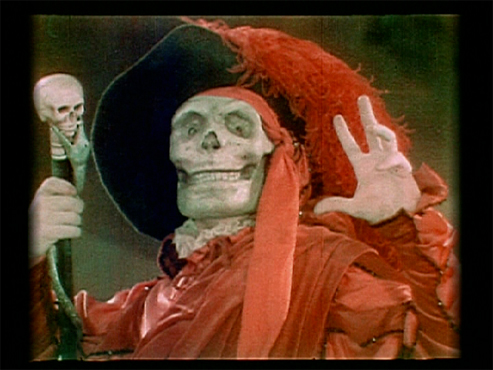
Also included in this set is the Photoplay Productions restoration edition of the 1929 version of the film (identified by Scott McQueen as the 1930 international synchronized sound rerelease version), accompanied by both the 1930 version of the mono soundtrack (with synchronized music and sound effects, and post-synched dialogue sequences, edited here to fit the source print) and a stereo music score composed by Carl Davis. This 1929 version has survived in a photographically superior 35mm print, which is the version of the film most-often seen in theater revivals and most-often offered on home video. This edition features the original Bal Masque Technicolor footage (preserved by George Eastman Museum) that has been previously available on home video. The footage is just a bit more vivid than we have seen anywhere else before. Photoplay Productions has also attempted to replicate the Max Handschiegl hand color-engraving process in the rooftop scene, as the Phantom’s red cape flutters in the breezes of the blue-tinted picture.
The video transfer is excellent, with sharp images and balanced greytones (which have digitally-added color tints). However, there is plenty of evidence of the use of computer-aided digital clean-up of the video transfer, which is intended to remove dust, speckling and emulsion scratches from the transfer by digitally comparing a frame with dust or damage to patch the areas of the image that are different from preceding and following frames. The indiscriminate over-use of the digital process here results in the optical removal of arms, legs and other swiftly moving objects from frame to frame, the featureless blurring of moderately moving objects, and image strobing in slower moving objects. The effect is so pronounced in the transfer of the 1929 version on this disc that it negatively distracts the viewer with its odd and unnatural replication of movement. It is not known to us whether this digital retouching was introduced by Photoplay Productions, the producers of this video edition of the 1929 release, or by Milestone Film & Video, the American publishers of this DVD. The horrid digital artifacts produced by this process severely compromises a home video edition that promised in advance to live up to its packaging touting it as “The Ultimate Edition.”
The DVD supplementary section includes audio commentary by Scott McQueen (to the 1929 version), personal recollections by Laemmle niece and Phantom bit player Carla Laemmle (6 min.), theatrical trailers for the 1925 and 1930 versions of the film, nine audio-only dialogue sequences from the 1929 domestic sound version, a 1973 audio interview with cinematographer Charles Van Enger by historian Richard Koszarski (9 min.), a stills gallery of missing and deleted scenes, and a Faust opera excerpt from Midstream (1929), a Tiffany sound feature (10 min.).
Unfortunately, we cannot recommend this edition for its 1929 version. The 1925 version on disc two, however, is a considerable improvement over the 1990 laserdisc edition and may be valuable enough (with the set’s supplementary material) to some collectors to warrant its purchase.
|
This Region 1 NTSC DVD edition has been discontinued
and is . . .
|

|
|
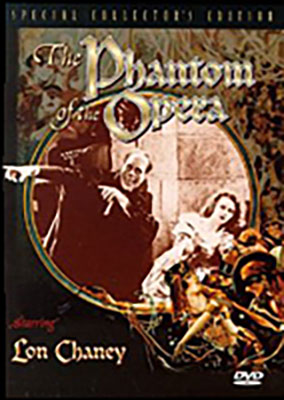 Film Preservation Associates Film Preservation Associates
1997 DVD edition
The Phantom of the Opera (1925) [1929 silent rerelease version], color-tinted black & white and color-toned black & white and color, 92 minutes, not rated.
Film Preservation Associates, distributed by Image Entertainment, ID4097DSDVD, UPC 0-14381-40972-7.
One single-sided, single-layered, Region 0 NTSC DVD disc; 1.33:1 aspect ratio picture in windowboxed 4:3 (720 x 480 pixels) interlaced scan image encoded in SDR MPEG-2 format at 5.8 Mbps average video bit rate (capable of progressive scan upscaling to 60 fps); Dolby Digital (AC3) 2.0 stereo sound encoded at 192 Kbps audio bit rate; English language intertitles, no subtitles; 12 chapter stops; closed captions; snapper DVD case (rereleased in standard DVD keepcase); $29.99 (reduced to $19.99).
Release date: 15 October 1997.
Country of origin: USA
Ratings (1-10): video: 6 / audio: 7 / additional content: 6 / overall: 6.
|
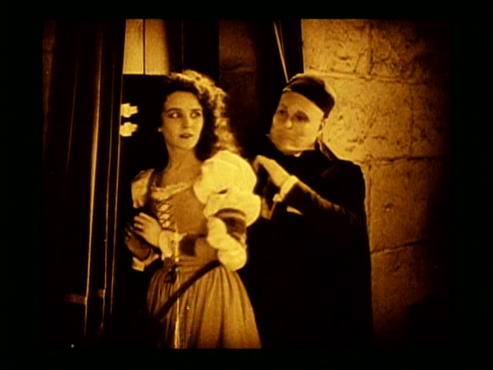
Home video producer David Shepard has released The Phantom of the Opera on home video before, in two laserdisc editions. The first laserdisc, released in 1990, was something of a treasure since it included the original 1925 version of the film and the 1929 synchronized sound rerelease version. However, the 1929 version was transferred at sound speed and subsequently ran too fast to be enjoyed. The 1925 version was presented in a flat contrast transfer from a battered 8mm reduction print, with no musical accompaniment. Shepard released another laserdisc edition of the 1929 version in 1995, with a new speed-corrected transfer and a new music track. The 1997 DVD edition at hand is virtually identical to that laserdisc edition.
The first thing one notices is the higher-quality windowbox transfer from a good to very-good 35mm print, with some light emulsion scuffing, speckling, scratches and other momentary print damage. The picture itself is not very sharp, but reflects the video transfer technology of the 1990s. Also, the print is rough, due to beginning print decomposition, in the sequence where Christine awakens in Erik’s underground lair and inspects the clothing he has provided for her.
This DVD edition of The Phantom of the Opera features an orchestral music score, with pipe organ and opera soprano Claudine Coté, commissioned by La Cinemateque Quebecoise and composed by Gabriel Thibaudoux in 1992. While the music is entertaining and quite welcome in this 1995 edition, the treble frequencies in the recording are slightly topped off, giving the music a moderately compressed and muffled sound. And while the synchronization is slightly out of sync with the picture in places, the music helps a film that can be tough going without a strong musical accompaniment. The music is appropriately eerie as Christine is taken by Erik into the catacombs.
The supplementary material includes excerpts from the 1925 version that were edited out of the 1929 rerelease version, a theatrical trailer, production stills and promotional materials, and notes on the film by Michael Blake.
This DVD of The Phantom of the Opera was the best available edition in the 1990s of the 1929 version in North America, with its improved video transfer and orchestral music score. But, we prefer the Milestone edition noted below for its edition of the 1925 version of the film. For all of our complaints about Julian’s subpar direction, it is better to have a slow but complete film than a chopped-up one.
|
This Region 0 NTSC DVD edition has been discontinued
and is . . .
|

|
|
 Miracle Pictures Miracle Pictures
2004 DVD edition
The Phantom of the Opera (1925) [1929 silent rerelease version], color-tinted black & white, color-toned black & white and color, 92 minutes, not rated, with The Hunchback of Notre Dame (1923), black & white, 110 minutes, not rated.
Miracle Pictures, no catalog number, UPC 0-90328-31011-0.
One dual-sided, single-layered, Region 0 NTSC DVD disc; 1.33:1 aspect ratio picture in windowboxed 4:3 (720 x 480 pixels) interlaced scan image encoded in SDR MPEG-2 format at 4.0 Mbps average video bit rate (capable of progressive scan upscaling to 60 fps); MPEG 2.0 stereo sound encoded at 192 Kbps audio bit rate; English language intertitles, no subtitles; 7 chapter stops; standard DVD keepcase; unknown suggested retail price.
Release date: 2004.
Country of origin: USA
Ratings (1-10): video: 6 / audio: 7 / additional content: 4 / overall: 6.
|

This budget DVD edition, repackaged by Miracle Pictures, may tempt someone who likes the idea of getting two films on the cheap but, often, you get what you pay for. This flipper disc has been lifted wholesale (legally or not) from the Film Preservation Associates 1997 DVD edition noted above. The visual quality of this disc is nearly the same as the FPA edition but still not ideal.
This edition is OK but not recommended when better releases noted above are available on Blu-ray Disc and DVD.
|
This Region 0 NTSC DVD edition has been discontinued
and is . . .
|

|
|
 Reel Classic DVD Reel Classic DVD
2009 DVD edition
The Phantom of the Opera (1925), black & white and color, 109 minutes, not rated, and The Phantom of the Opera (1925) [1929 silent rerelease version], black & white and color, 76 minutes, not rated, The Phantom of the Opera (1925) [1929 silent rerelease version], black & white, 76 minutes, not rated, with The Light in the Dark (1922) [abridged The Light of faith version], color-toned black & white, 32 minutes, not rated.
Reelclassicdvd.com, no catalog number, UPC 7-62185-05132-0.
Four single-sided, single-layered, Region 0 NTSC DVD-R discs; 1.33:1 aspect ratio picture in full-frame 4:3 (720 x 480 pixels) interlaced scan image encoded in SDR MPEG-2 format at 5.2 Mbps average video bit rate (capable of progressive scan upscaling to 60 fps); Dolby Digital (AC3) 2.0 stereo sound encoded at 192 Kbps audio bit rate; English language intertitles, no subtitles; 16 chapter stops (disc one), 23 chapter stops (disc three); two standard two-disc DVD keepcases; $35.00.
Release date: 2009
Country of origin: USA
Ratings (1-10): video: 5 / audio: 5 / additional content: 7 / overall: 5.
|
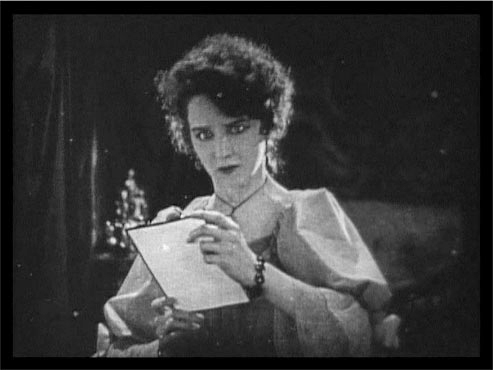
This four-disc DVD-R edition features three different presentations of the various survival states of The Phantom of the Opera.
The presentation on disc one has been transferred from a 16mm reduction print of the 1929/1930 version as prepared by Griggs Moviedrome in 1974, featuring a theater pipe organ music score performed by Lee Erwin, and with the opening introduction by the man with the lantern voiced by John Griggs. Griggs prints featured the Bal Masque sequence with the original black & white version footage, however, edition producer Mark Roth has inserted the survivng Technicolor footage from another print. The 1974 Griggs edition of the 1929/1930 version of the film is presented unaltered on disc two. This home video edition from the Griggs print will be slightly different from other 16mm-based discs prepared from the commonly-available 16mm Blackhawk prints due to slight differences in surviving material in their original source prints. The Griggs print itself is good to very-good, with a persistent amount of dust and speckling, but much of the print is dark, with closed-up shadows and grey highlights. Still quite watchable, but not ideal. It is interesting that the credits at the end of the print are from the 1925 version, with Virginia Pearson credited as Carlotta.
The presentation on disc three is the 1925 version of the film, presented from a 16mm duplicate reduction print of the 16mm Show-At-Home edition, with an insert of the color Bal Masque footage. This closest approximation of the original general-release version of the film has not survived in the best print condition, and this edition of that print does not look as good as the presentation on the Milestone edition noted above.
The 1925 version of the film is presented with a new music score composed and performed on Miditzer virtual (computer-based) theatre pipe organ by Ben Model.
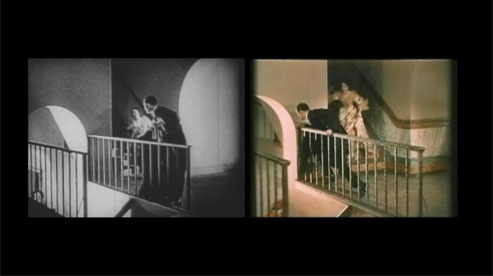
Disc four is the highlight of this set. The main feature of this disc is a side-by-side comparison of footage from the 1929/1930 version of film (on the left) next to the surviving 1925 footage (on the right, recut to conform to the 1929 version). The comparison is a revelation, as A-B camera footage shows different views of the same performance, different takes of the same scene, and identical footage from the same camera in a dizzying parade. For instance, we have previously believed that the 1929 version featured reshot footage of the ballet, but it now appears that unused alternate footage from other cameras taken around the huge theater set in 1925 was chosen for the 1929 reedit of the film. What is apparent to us from this presentation is that the majority of the footage in one print (even of the same performance) is taken from a different camera in the other print. The 1925 footage appears to have predominantly been taken from the right camera position, with the 1929 footage taken from the left camera position. The presentation also makes possible an examination of the intertitle changes made to the 1929 version. The Technicolor footage has been added to the 1925 print for this comparison.
A presentation of this sort could make an attempt to reconstruct the 1925 general-release version of the film from the best surviving footage, with the original sequence editing and intertitles, a little easier to evaluate. Any such reconstruction would require the evaluation and conflation of many source prints, we know, but this presentation shows that many subjective decisions would have to be have made by such a restoration team. Fascinating. Also, Keith Paynter narrates a side-by-side comparison of the black & white and Technicolor footage of the Bal Masque sequence (3 minutes).
Among the supplemental material is a good-looking 16mm reduction print of the 1925 theatrical trailer for the film (3 minutes); Scream Scenes (circa 1959) which includes footage from The Phantom of the Opera, some of it unique? (5 minutes); and a presentation of the Light of Faith version of The Light in the Dark (1922).
OK, so, neither surviving version of of the film is well-represented on home video by these source prints. But, we do think that side-by-side comparisons of prints of the 1929/1930 version would reveal differences in what is supposed to be the same version of the film. So, this DVD edition might contain the best representation on home video of the Griggs Moviedrome 16mm reduction print, but it would be for the side-by-side comparison of the 1929/1930 footage and the 1925 footage that we would recommend this edition.
|
This Region 0 NTSC DVD-R edition is available from
REEL CLASSIC DVD through . . .
|

|
|
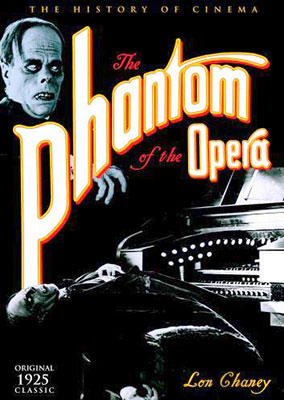 Delta Entertainment Delta Entertainment
2004 DVD edition
The Phantom of the Opera (1925) [1929 silent rerelease version], black & white and color, 79 minutes, not rated.
Delta Entertainment, 82 347, UPC 0-18111-23479-5.
One single-sided, single-layered, Region 0 NTSC DVD disc; 1.33:1 aspect ratio picture in full-frame 4:3 (720 x 480 pixels) interlaced scan image encoded in SDR MPEG-2 format at 5.0 Mbps average video bit rate (capable of progressive scan upscaling to 60 fps); LPCM 5.1 mono sound encoded at 1.5 Mbps audio bit rate; English language intertitles, no subtitles; 9 chapter stops; insert poster; standard DVD keepcase; $6.99.
Release date: 24 February 2004.
Country of origin: USA
Ratings (1-10): video: 5 / audio: 5 / additional content: 0 / overall: 5.
|
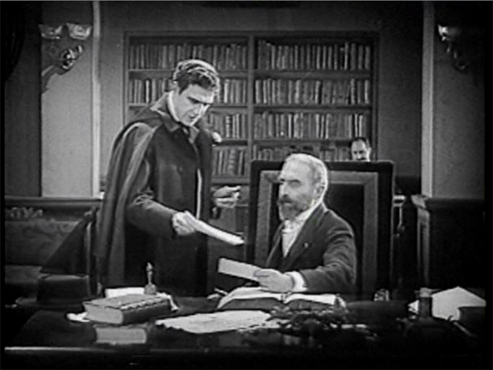
Surprisingly, this budget DVD edition appears to have been prepared from 35mm print materials, but the disc itself also appears to have been mastered from an older sound-speed analog video transfer. The image’s highlights are slightly hot and produce a faint ghost image to the right, which most viewers will not see.
The source print is slight but persistently speckled, with some dust, scratches, and other age-related damage. The print or the video transfer is darker is places than it should be. The transfer framing is a little tight, with the top and left portions of the picture overcropped. But, the film is far easier viewing here than in other editions transferred from 16mm reduction prints.
The film’s color footage is, in the source print used for the video transfer, seriously shifted into orangey-red and gives little sense of what the original two-part Technicolor footage looked like.
This edition is accompanied by a custom music score performed on synthesizers, with sound effects and brief narration. The soundtrack is stuck in a surround system’s center channel, and has a prominent amount of hiss.
For a budget edition, the film fares better on this disc than on most other cheap releases of The Phantom of the Opera. In you can’t bring yourself to spring for one of the high-quality editions noted above, this disc is your best option for quality against value.
|
|
DELTA ENTERTAINMENT has discontinued business and this Region 0 NTSC DVD edition is . . .
|

|
|
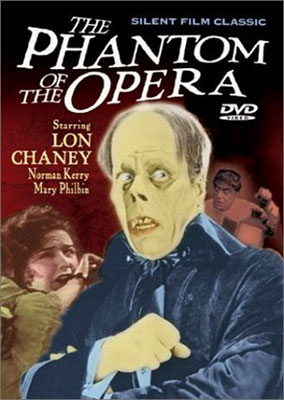 Alpha Video Alpha Video
2001 DVD edition
The Phantom of the Opera (1925) [1929 silent rerelease version], black & white and color, 106 minutes, not rated.
Alpha Home Entertainment, distributed by Oldies.com,
ALP 3188D, UPC 0-89218-31889-3.
One single-sided, single-layered, Region 0 NTSC DVD-R disc; 1.33:1 aspect ratio picture in full-frame 4:3 (720 x 480 pixels) interlaced scan image encoded in SDR MPEG-2 format at 4.5 Mbps average video bit rate (capable of progressive scan upscaling to 60 fps); Dolby Digital (AC3) 2.0 mono sound encoded at 196 Kbps audio bit rate; English language intertitles, no subtitles; 5 chapter stops; standard DVD keepcase; $6.98 (raised again to $9.99).
Release date: 27 November 2001.
Country of origin: USA
Ratings (1-10): video: 3 / audio: 4 / additional content: 0 / overall: 3.
|
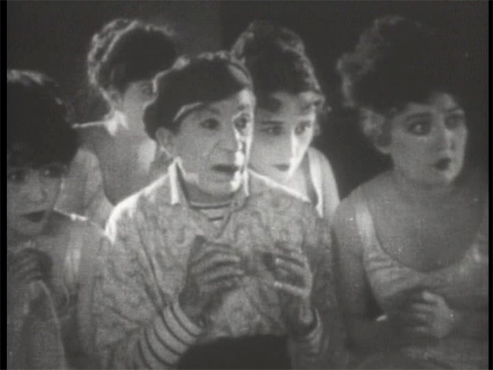
You get what you pay for. And a DVD for less than ten dollars is hardly a deal unless you care nothing for quality.
This DVD edition from Alpha Video Distributors features a video transfer from a good 16mm reduction print, with the Technicolor sequences in color. The print is a little soft in image details but maintains a good range of greytones but a little washed out, and is flawed by moderate speckling, scratches and emulsion scuffing. The Technicolor sequence is pale and muddy. The transfer frame rate is at the correct speed to replicate natural motion, which accounts for the film’s running time of 106 minutes (despite the packaging listing of 94 minutes). This is one of the few good things that can be said about this edition.
This edition of The Phantom of the Opera features a cobbled-together orchestral music score of classical music pieces. The tonal quality is okay, but little has been done to sequence the music to the film’s action. Overall, the print is passable and the transfer is okay, with much of the highlight and shadow details remaining reasonably intact through the reduction print duplication and the video transfer. The disc is just not up to snuff for the quality-conscious consumer.
It should be no surprise that this DVD edition of The Phantom of the Opera pales in comparison to the David Shepard edition released by Kino Lorber.
|
This
Region 0 NTSC DVD-R edition is available from
ALPHA VIDEO through . . .
|

|
|
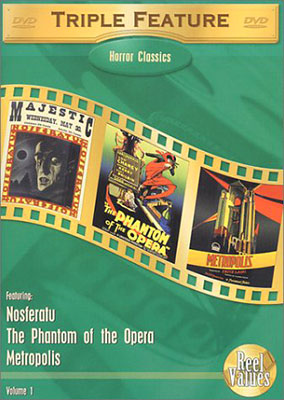 Navarre Corporation Navarre Corporation
2002 DVD edition
Triple Feature Horror Classics, Volume 1 (1922-1927), black & white and color, 306 minutes total, not rated, including The Phantom of the Opera (1925) [1929 silent rerelease version], black & white and color, 106 minutes, not rated.
Navarre Corporation, 1613, UPC 7-41027-16139-3.
One single-sided, dual-layered, Region 0 NTSC DVD disc; 1.33:1 aspect ratio picture in full-frame 4:3 (720 x 480 pixels) interlaced scan image encoded in SDR MPEG-2 format at 2.5 Mbps average video bit rate (capable of progressive scan upscaling to 60 fps); Dolby Digital (AC3) 2.0 mono sound encoded at 192 Kbps audio bit rate; English language intertitles, no subtitles; 12 chapter stops; standard DVD keepcase; $9.98.
Release date: 12 March 2002.
Country of origin: USA
Ratings (1-10): video: 4 / audio: 4 / additional content: 4 / overall: 4
|
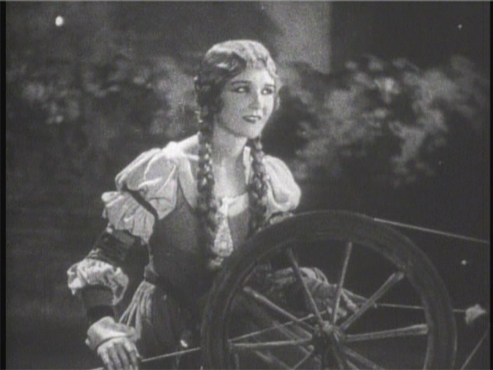
The Phantom of the Opera is another silent era film that is commonly available in high and low quality editions. This silent era standard is very well known but not well represented here.
This DVD edition has been mastered from the same video transfer as the Alpha Video edition above. The film has been transferred from a slightly contrasty good to very-good quality 16mm reduction print of the 1929 rerelease version. The worn print has been transferred at the appropriate silent speed. The Technicolor sections are here but have been poorly duplicated in the 16mm print, giving an inaccurate representation of the quality of the surviving color footage. The shots are seen mostly in red and black tones, with some bluish-green tones prevalent on the sides of the picture. Compared to the Alpha Video edition, the color sections in this Navarre edition are richer and more saturated — still looking little like the original Technicolor. The 16mm print has been tightly cropped but the transfer still allows intertitles to be readable on most television monitors.
The film is accompanied by a canned orchestral score that is identical to the Alpha Video edition above.
|
This Region 0 NTSC DVD edition has been discontinued
and is . . .
|

|
|
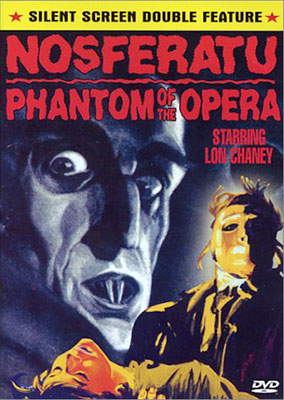 Diamond Entertainment Diamond Entertainment
2002 DVD edition
The Phantom of the Opera (1925) [1929 silent rerelease version], black & white, 79 minutes, not rated, with Nosferatu (1922), black & white, 63 minutes, not rated.
Diamond Entertainment, 98604, UPC 0-11891-98604-5.
One single-sided, dual-layered, Region 0 NTSC DVD disc; 1.33:1 aspect ratio picture in full-frame 4:3 (720 x 480 pixels) interlaced scan image encoded in SDR MPEG-2 format at 4.5 Mbps average video bit rate (capable of progressive scan upscaling to 60 fps); Dolby Digital (AC3) 2.0 mono sound encoded at 256 Kbps audio bit rate; English language intertitles, no subtitles; 8 chapter stops; standard DVD keepcase; $19.99.
Release date: 30 July 2002.
Country of origin: USA
Ratings (1-10): video: 4 / audio: 4 / additional content: 5 / overall: 4.
|
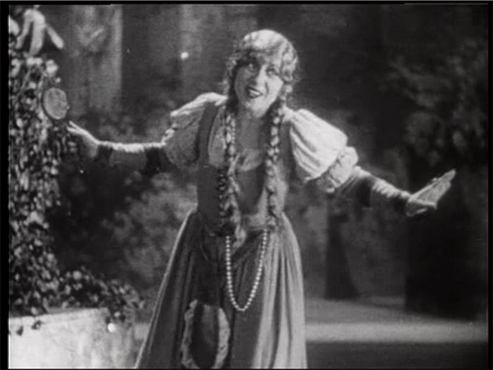
Other DVD releases from Diamond Entertainment have utilized both 35mm and 16mm prints, and have ranged in quality from good to excellent. However, this edition of The Phantom of the Opera has been prepared from a 16mm reduction print of good to very-good quality. The image detail is soft due to the print, and it contains a persistent amount of speckling, with some scuffing and other damage that was probably present in the source print from which the reduction print was struck. But the print is, at least, watchable. Despite packaging statements, this edition is presented entirely in black & white.
The film is accompanied by a canned orchestral score that doesn’t match the film’s action. See our Nosferatu on home video page for our comments on this edition of Nosferatu. Again, why buy this edition when there are better to be had.
|
This Region 0 NTSC DVD edition has been discontinued
and is . . .
|

|
|
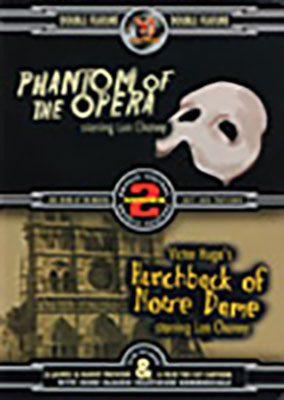 Catcom Home Video Catcom Home Video
2002 DVD edition
The Phantom of the Opera (1925) [1929 silent rerelease version], black & white, 79 minutes, not rated, with The Hunchback of Notre Dame (1923), black & white, 101 minutes, not rated, The Mechanical Cow (1927), color-tinted black & white, 6 minutes, not rated, Felix Minds the Kid (1922), black & white, 8 minutes, not rated, Gertie on Tour (c. 1918-1921), black & white, 2 minutes, not rated.
Catcom Home Video, CAT0147-6, UPC 7-41914-01476-8.
One single-sided, dual-layered, Region 0 NTSC DVD disc; 1.33:1 aspect ratio picture in full-frame 4:3 (720 x 480 pixels) interlaced scan image encoded in SDR MPEG-2 format at 5.6 Mbps average video bit rate (capable of progressive scan upscaling to 60 fps); Dolby Digital (AC3) 2.0 mono sound encoded at 192 Kbps audio bit rate; English language intertitles, no subtitles; 3 chapter stops; standard DVD keepcase; unknown suggested retail price.
Release date: 2002.
Country of origin: USA
Ratings (1-10): video: 3 / audio: 3 / additional content: 3 / overall: 3.
|
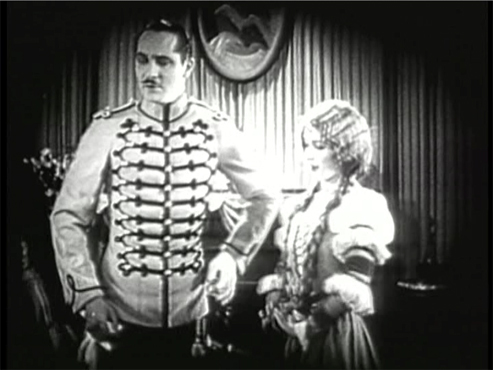
This DVD edition shows up from time to time on eBay and at low-cost retailers. It has been mastered from an all black & white 16mm reduction print of the 1929 rerelease version of the film. The highlights of the contrasty video transfer are also often blasted out to a detailless white and have a quite detectable smear to the right, especially noticable in the intertitles, which indicates an older analog videotape master. The disc does have its share of videotape playback glitches, as well.
The film is accompanied by a music score performed on a synthesizer programmed to emulate a pipe organ, which repeats its performance of the same music without variation throughout the film. How many times can you listen to the same Bach organ piece? Test your endurance with this disc.
The disc also includes a Disney Oswald cartoon, a contrasty Felix the Cat cartoon, a Winsor McCay cartoon fragment lifted directly from the Lumivision edition (music and all), and television commercials.
We do not recommend this edition. Even among the cheapy discs, there are better-looking editions to be had.
|
This Region 0 NTSC DVD edition has been discontinued
and is . . .
|

|
|
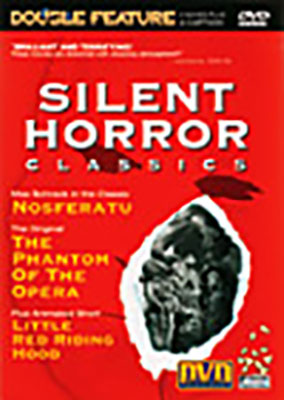 PC Treasures PC Treasures
2004 DVD edition
Silent Horror Classics (1922-1949), black & white and color, ? minutes total, not rated, including The Phantom of the Opera (1925) [1929 silent rerelease version], black & white, 106 minutes, not rated.
PC Treasures, 10004, UPC 6-71196-10004-3.
One single-sided, single-layered, Region 0 NTSC DVD disc; 1.33:1 aspect ratio picture in full-frame 4:3 (720 x 480 pixels) interlaced scan image encoded in SDR MPEG-2 format at 2.0 Mbps average video bit rate (capable of progressive scan upscaling to 60 fps); no audio tracks; English language intertitles, no subtitles; no chapter stops; disc envelope in a cardboard box; unknown suggested retail price.
Release date: 2004.
Country of origin: USA
Ratings (1-10): video: 3 / audio: 0 / additional content: 3 / overall: 3.
|
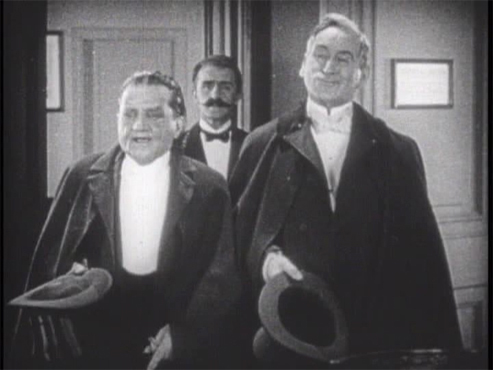
Here we go again. This ultra cheap DVD edition has been mastered from a soft and slightly greyed-out 16mm reduction print, which is speckled and flecked with dust, and the film is presented without any type of musical accompaniment.
The disc also presents an early Ray Harryhausen short. Should you even consider this one, given its cheap price? Nope.
|
This Region 0 NTSC DVD edition has been discontinued
and is . . .
|

|
|
 Ovation Home Video Ovation Home Video
2003 DVD edition
The Phantom of the Opera (1925) [1929 silent rerelease version], black & white, 75 minutes, not rated.
Ovation Home Video, 40445, UPC 0-84296-40445-2.
One single-sided, single-layered, Region 0 NTSC DVD disc; 1.33:1 aspect ratio picture in full-frame 4:3 (720 x 480 pixels) interlaced scan image encoded in SDR MPEG-2 format at 6.0 Mbps average video bit rate (capable of progressive scan upscaling to 60 fps); Dolby Digital (AC3) 2.0 mono sound encoded at 192 Kbps audio bit rate; English language intertitles, no subtitles; 14 chapter stops; standard DVD keepcase; unknown suggested retail price.
Release date: 2003.
Country of origin: USA
Ratings (1-10): video: 3 / audio: 0 / additional content: 1 / overall: 3.
|
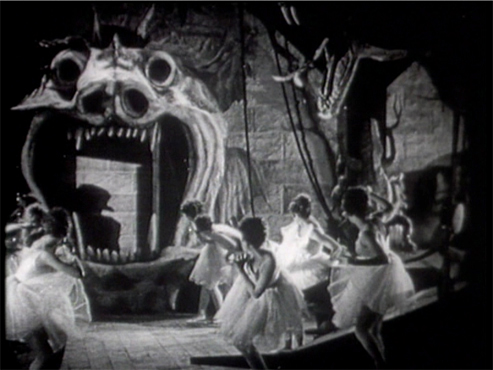
This budget DVD edition has been mastered from a soft 16mm reduction print, which is speckled and flecked with dust. The video transfer has been made at sound speed and resultantly runs too fast.
The film is accompanied by a theatre organ music score, with a roughly synchronized voice-over of the original 1929 sound version introduction in the opera catacombs.
|
This Region 0 NTSC DVD edition has been discontinued
and is . . .
|

|
|
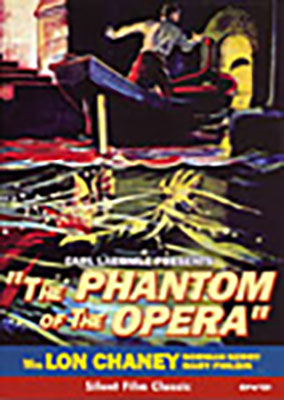 Digiview Entertainment Digiview Entertainment
2005 DVD edition
The Phantom of the Opera (1925) [1929 silent rerelease version], black & white, 106 minutes, not rated, with The Hunchback of Notre Dame (1923), black & white, 101 minutes, not rated.
Digiview Entertainment, MV-956, UPC 8-72322-00753-7.
One single-sided, single-layered, Region 0 NTSC DVD disc; 1.33:1 aspect ratio picture in full-frame 4:3 (720 x 480 pixels) interlaced scan image encoded in SDR MPEG-2 format at 2.4 Mbps average video bit rate (capable of progressive scan upscaling to 60 fps); Dolby Digital (AC3) 2.0 stereo sound encoded at 256 Kbps audio bit rate; English language intertitles, no subtitles; 6 chapter stops; slimline DVD keepcase; unknown suggested retail price.
Release date: 2005.
Country of origin: USA
Ratings (1-10): video: 2 / audio: 4 / additional content: 3 / overall: 3.
|
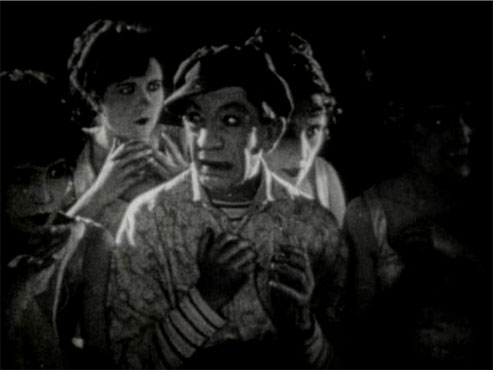
A double-feature DVD edition of the above release utilizes the same old natural-speed full-frame video transfer, with the same classical music, from the same old substandard 16mm reduction print as the other cheapy editions above such as those from Alpha and Navarre. And, of course, it is darker than the others, with plugged shadows and coarse image details. The print is significantly marked with dust and speckling.
Not exactly what we would call a quality product, and not recommended when there are better editions available. No surprises there.
|
This Region 0 NTSC DVD edition has been discontinued
and is . . .
|

|
|
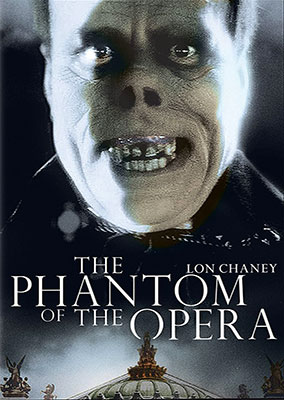 Film Preservation Associates Film Preservation Associates
2011 DVD edition
The Phantom of the Opera (1925) [1929 silent rerelease version], color-toned black & white and color, 92 minutes, not rated, and The Phantom of the Opera (1925) [1929 silent rerelease version], color-toned black & white and color, 78 minutes, not rated, with The Phantom of the Opera (1925), color-tinted black & white, ? minutes, not rated.
Film Preservation Associates, distributed by Image Entertainment, unknown number, unknown UPC number.
One single-sided, single-layered, Region 0 NTSC DVD disc; 1.33:1 aspect ratio picture in full-frame 4:3 (720 x 480 pixels) interlaced scan image encoded in SDR MPEG-2 format at ? Mbps average video bit rate (capable of progressive scan upscaling to ? fps); Dolby Digital (AC3) 2.0 stereo sound encoded at ? Kbps audio bit rate; English language intertitles, no subtitles; chapter stops; standard DVD keepcase; $29.99.
Release date: 1 November 2011.
Country of origin: USA
|
|
This remastered DVD edition of The Phantom of the Opera is something of a mystery, as it may not have actually been released. The Blu-ray Disc sister edition of this disc is noted above.
If you own a copy of this disc please consider loaning it to us to review for documentation purposes. We pay postage both ways.
|
This Region 0 NTSC DVD edition has been discontinued
and is . . .
|

|
|
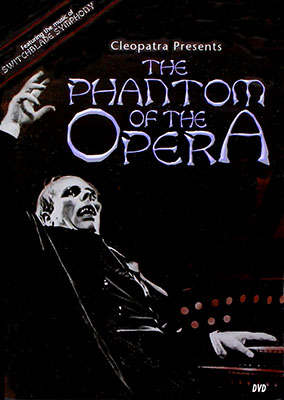 Cleopatra Records Cleopatra Records
2002 DVD edition
The Phantom of the Opera (1925), black & white, 93 minutes, not rated.
MVD Visual,
unknown catalogue number, unknown UPC number.
One single-sided, single-layered, Region 0 NTSC DVD disc; 1.33:1 aspect ratio picture in full-frame 4:3 (720 x 480 pixels) interlaced scan image encoded in SDR MPEG-2 format at ? Mbps average video bit rate (capable of progressive scan upscaling to ? fps); Dolby Digital (AC3) 2.0 stereo sound encoded at ? Kbps audio bit rate; English language intertitles, no subtitles; chapter stops; standard DVD keepcase; $7.95.
Release date: 7 May 2002.
Country of origin: USA
|
|
This DVD edition may have been mastered from quality print materials.
The film is accompanied by a music score performed by metal band Switchblade Symphony.
If you own a copy of this disc please consider loaning it to us to review for documentation purposes. We pay postage both ways.
|
This Region 0 NTSC DVD edition has been discontinued
and is . . .
|

|
|
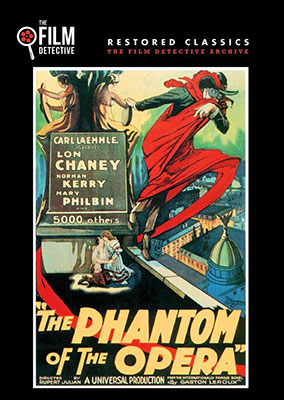 The Film Detective The Film Detective
2015 DVD edition
The Phantom of the Opera (1925) [1929 silent rerelease version], black & white and color, 93 minutes, not rated.
The Film Detective,
unknown catalog number, UPC 8-89290-44040-2.
One single-sided, single-layered, Region 0 NTSC DVD-R disc; 1.33:1 aspect ratio picture in full-frame 4:3 (720 x 480 pixels) interlaced scan image encoded in SDR MPEG-2 format at ? Mbps average video bit rate (capable of progressive scan upscaling to ? fps); Dolby Digital (AC3) 2.0 stereo sound encoded at ? Kbps audio bit rate; English language intertitles, no subtitles; chapter stops; standard DVD keepcase; $9.99.
Release date: 26 November 2015.
Country of origin: USA
|
|
This DVD-R edition has likely been mastered from a 16mm reduction print.
The film is likely to be accompanied by a soundtrack compiled from preexisting recordings.
|
This Region 0 NTSC DVD-R edition is available from
THE FILM DETECTIVE through . . .
|

|
|
 Miracle Pictures Miracle Pictures
2001 DVD edition
The Phantom of the Opera (1925) [1929 silent rerelease version], black & white, 92 minutes, not rated.
Miracle Pictures, no catalog number, UPC 0-90328-30166-8.
One single-sided, single-layered, Region 0 NTSC DVD disc; 1.33:1 aspect ratio picture in windowboxed 4:3 (720 x 480 pixels) interlaced scan image encoded in SDR MPEG-2 format at ? Mbps average video bit rate (capable of progressive scan upscaling to ? fps); DTS 1.0 stereo sound encoded at ? Kbps audio bit rate, and Dolby Digital (AC3) 1.0 mono sound encoded at ? Kbps audio bit rate; English language intertitles, no subtitles; chapter stops; standard DVD keepcase; unknown suggested retail price.
Release date: 27 November 2001.
Country of origin: USA
|
|
This budget DVD edition showed up for sale on eBay. Don’t expect much in the way of quality, it has likely been transferred from a substandard 16mm reduction print and sells new for as little as $2.98.
If you own a copy of this disc please consider loaning it to us to review for documentation purposes. We pay postage both ways.
|
This Region 0 NTSC DVD edition has been discontinued
and is . . .
|

|
|
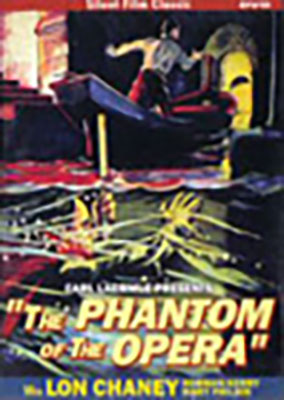 Digiview Productions Digiview Productions
2004 DVD edition
The Phantom of the Opera (1925) {1929 silent rerelease version}, black & white, 106 minutes, not rated.
Digiview Productions, MV-543, unknown UPC number.
One single-sided, single-layered, Region 0 NTSC DVD disc; 1.33:1 aspect ratio picture in full-frame 4:3 (720 x 480 pixels) interlaced scan image encoded in SDR MPEG-2 format at ? Mbps average video bit rate (capable of progressive scan upscaling to ? fps); Dolby Digital (AC3) 2.0 stereo sound encoded at ? Kbps audio bit rate; English language intertitles, no subtitles; chapter stops; slimline DVD keepcase; unknown suggested retail price.
Release date: 2004.
Country of origin: USA
|
|
Yet another budget DVD edition from eBay and Wal-Mart, manufactured in China and marketed in the USA. When will this stop?
If you own a copy of this disc please consider loaning it to us to review for documentation purposes. We pay postage both ways.
|
This Region 0 NTSC DVD edition has been discontinued
and is . . .
|

|
|
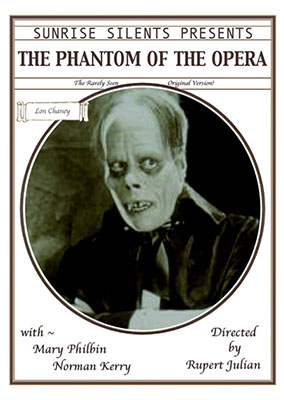 Sunrise Silents Sunrise Silents
2005 DVD edition
The Phantom of the Opera (1925), color-tinted black & white, 104 minutes, not rated.
Sunrise Silents,
POTO-N (NTSC) and POTO-P (PAL), no UPC number.
One single-sided, single-layered, Region 0 NTSC or PAL DVD-R disc; 1.33:1 aspect ratio picture in full-frame 4:3 (720 x 480 pixels) interlaced scan image encoded in SDR MPEG-2 format at ? Mbps average video bit rate (capable of progressive scan upscaling to ? fps); Dolby Digital (AC3) 2.0 stereo sound encoded at ? Kbps audio bit rate; English language intertitles, no subtitles; chapter stops; standard DVD keepcase; $19.95.
Release date: 2005.
Country of origin: USA
|
|
This DVD-R edition has likely been transferred from a 16mm reduction print, but justifies its release since it is a print of the original 1925 version of the film.
The film is likely accompanied by a custom music score on MIDI synthesizer.
If you own a copy of this disc please consider loaning it to us to review for documentation purposes. We pay postage both ways.
|
|
SUNRISE SILENTS has discontinued business and this edition is . . .
|

|
|
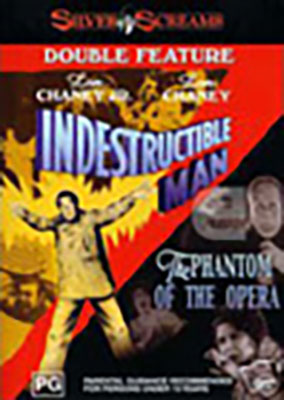 Unknown Australian Unknown Australian
200? DVD edition
The Phantom of the Opera (1925), black & white, ? minutes, not rated, with Indestructible Man (1956), black & white, 70 minutes, not rated.
Unknown home video company,
unknown catalogue number, unknown UPC number.
One single-sided, dual-layered, Region 0? PAL DVD disc; 1.33:1 aspect ratio picture in full-frame 4:3 (720 x 576 pixels) interlaced scan image encoded in SDR MPEG-2 format at ? Mbps average video bit rate (capable of progressive scan upscaling to ? fps); Dolby Digital (AC3) 2.0 mono sound encoded at ? Kbps audio bit rate; English language intertitles (The Phantom of the Opera only), no subtitles; chapter stops; standard DVD keepcase; unknown suggested retail price.
Release date: 200?
Country of origin: Australia
|
|
This DVD edition from Australia features a transfer from unknown gauge materials which may originate from the 1929 rerelease version.
North American collectors will need a region-free PAL DVD player capable of outputting an NTSC-compatible signal to view this edition.
If you own a copy of this disc please consider loaning it to us to review for documentation purposes. We pay postage both ways.
|
This Region 0 NTSC DVD edition has been discontinued
and is . . .
|

|
|
|
Other silent era LON CHANEY films available on home video.
Other HORROR FILMS of the silent era available on home video.
Other TECHNICOLOR FILMS of the silent era available on home video.
Other silent film music scores by THE ALLOY ORCHESTRA available on home video.
Other silent film music scores by CARL DAVIS available on home video.
|
|

LINKS IN THIS COLUMN
MAY TAKE YOU TO
EXTERNAL WEBSITES
•
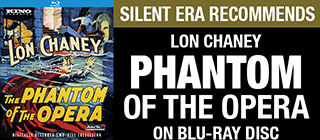
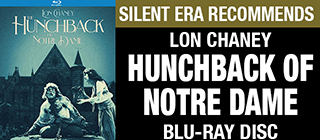
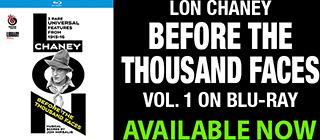
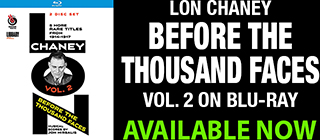
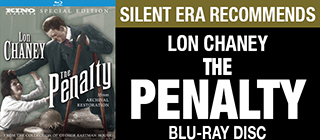


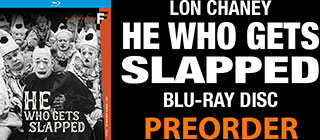
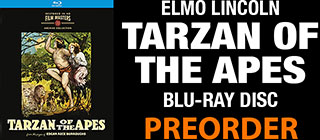


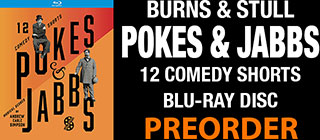

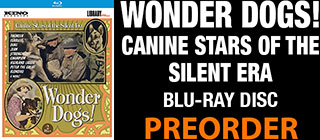
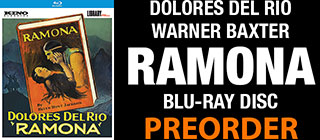
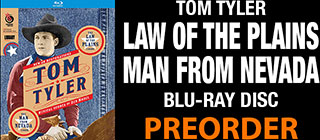
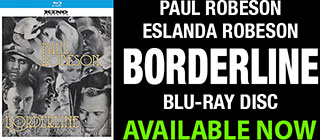
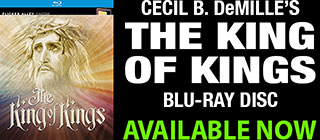
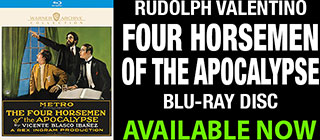
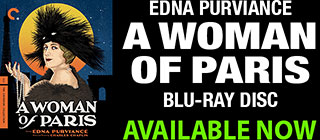
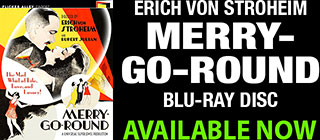
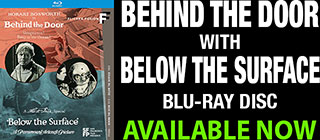
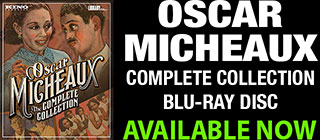
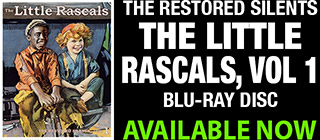
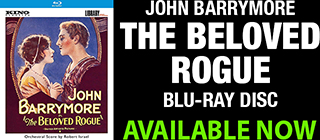
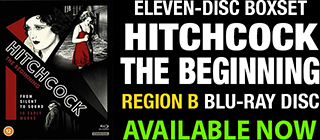
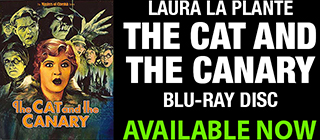
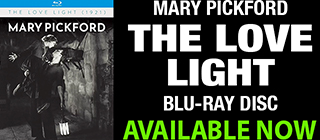
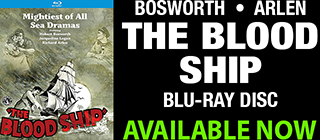

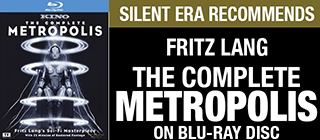


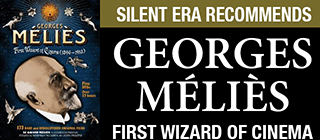
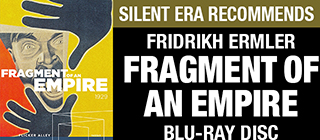
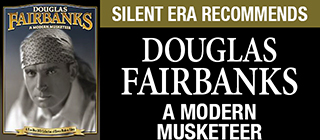

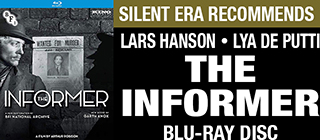
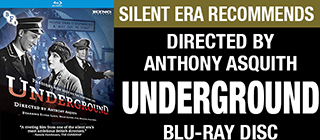
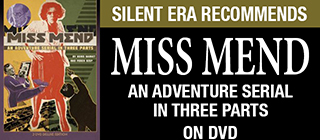
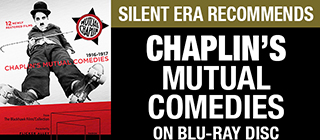
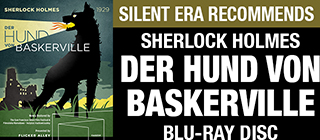
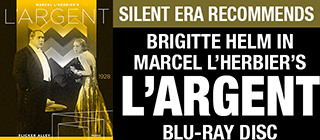
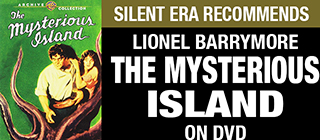
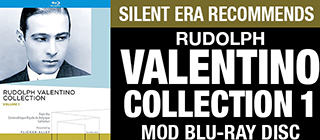
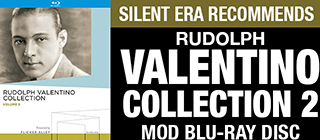
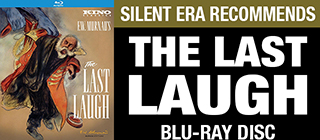
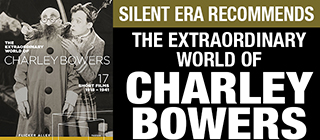
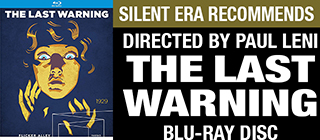
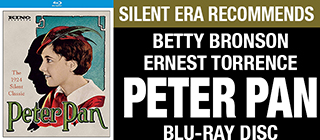
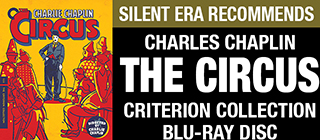

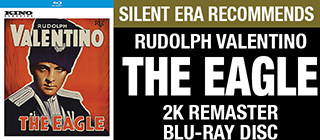
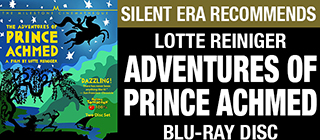
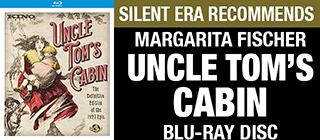
•
|




































